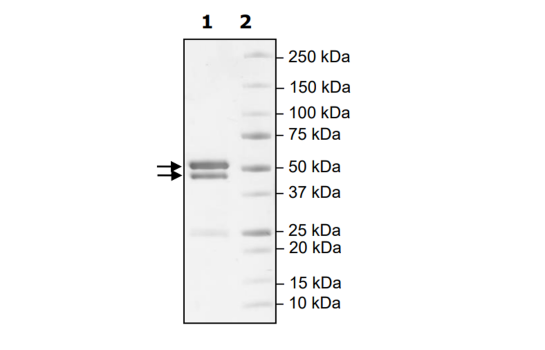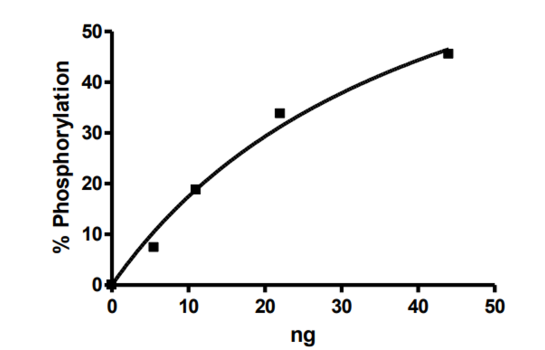CDK5/p25, GST-tag Recombinant
Catalog #
40105
$355
*
●
●
Purchase
Description
Complex of human CDK5, GenBank Accession No.NM_004935, a.a. 1-292(end) with N-terminal GST-tag, MW=60 kDa, and p25, GenBank Accession No.NM_003885, a.a. 99-307(end), with N-terminal GST-tag, MW=50 kDa. Coexpressed in a Baculovirus-infected Sf9 cell expression system.
This product has been cited 2 times.
●
Synonyms
Cyclin-Dependent Kinase-5, CDK5: PSSALRE
p25: CDK5R1; CDK5P35, CDK5R, NCK5A, p23, p35, p35nck5a, CDK-5
p25: CDK5R1; CDK5P35, CDK5R, NCK5A, p23, p35, p35nck5a, CDK-5
●
Product Data Gallery
Product Info
Storage and Usage
Citations2
Species
Human
Host Species/Expression System
Sf9 insect cells
Purity
≥80%
Format
Aqueous buffer solution
Formulation
40 mM Tris-HCl, pH 8.0, 110 mM NaCl, 2.2 mM KCl, 4 mM glutathione, 0.04% Tween-20, and 20% glycerol
MW
60 kDa (CDK5), 50 kDa (p25)
Amino Acids
CDK5 1–292 (end), p25 99–307 (end)
Specific Activity
312 pmol/min/μg
Genbank #
NM_004935, NM_003885
UniProt #
Q00535 (CDK5), Q15078 (p35)
Background
CDK5 is a member of the Cyclin-Dependent Kinase family that is most abundant in the mammalian brain. Active form of CDK5, which has also been called neuronal cdc2-like kinase, is a heterodimer of CDK5 and a 25 kDa protein which is derived proteolytically from a 35 kDa brain and neuron-specific protein and is essential for the kinase activity of CDK5 (1). CDK5 has emerged as a crucial regulator of neuronal migration in the developing central nervous system. CDK5 phosphorylates a diverse list of substrates, implicating it in the regulation of a range of cellular processes - from adhesion and motility, to synaptic plasticity and drug addiction (2).
References
1. Tang, D. et al: Cyclin-dependent kinase 5 (Cdk5) and neuron-specific Cdk5 activators. Prog Cell Cycle Res. 1996;2:205-16.
2. Dhavan, R. et al: A decade of CDK5. Nat Rev Mol Cell Biol. 2001 Oct;2(10):749-59.
Application Reference(s):
1. A cyclin-dependent kinase 5-derived peptide inhibits Cdk5/p25 activity and improves neurodegenerative phenotypes (2020)



